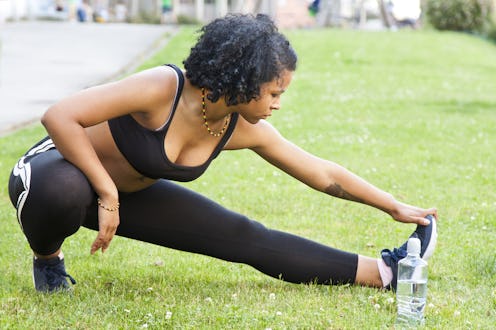Life
A New Study Reveals A Major Reason To Reconsider Your HIIT Workout

When it comes to the world of fitness classes, there’s no shortage of options. From hip-hop yoga to group circuit training, there’s a different kind of exercise available no matter what your skill level or workout preference. Among these options, high-intensity interval training (HIIT) is often touted as an efficient and ideal workout to get active in a shorter period of time than a typical hour-long class. Of course, as with most good things, it turns out that there’s a catch. New research suggests that people who engage in HIIT workouts are at a greater risk for injury, particularly in their shoulders and knees — which may not come as a surprise to anyone who's ever done an intense set of burpees.
HIIT workouts are intense cardio sessions that focus on short bursts of exercise where you push yourself to the limit, and the workout’s benefits include improved heart health and building lean muscle mass. The study, published in the Journal of Sports Medicine and Physical Fitness, was inspired by the exercise’s rise in popularity over the past decade. It focused on data from the National Electronic Injury Surveillance System to assess the number of injuries relative to exercise moves commonly used in HIIT programs, like push-ups, lunges, and burpees. The researchers also looked at injuries linked to exercise equipment common in HIIT workouts, including kettlebells, barbells, and boxes. The number of injuries were compared between 2007-2011 and 2012-2016, and Google Trends was used to determine the popularity of HIIT during those respective periods.
In total, there was roughly 4 million injuries that fit the study criteria, with nearly 60 percent of them occurring in men. Most of the injuries affected the knees, ankles and shoulders. On average, the study found a steady increase of 50,944 injuries per year, correlating to the growth in interest in HIIT workouts during the same time period. The researchers said that contributing factors to the increased risk for injury were poor form and muscle overuse in HIIT workouts.
"These workouts are marketed as 'one size fits all.' However, many athletes, especially amateurs, do not have the flexibility, mobility, core strength and muscles to perform these exercises," study co-author Joseph Ippolito, a physician in the department of orthopedics at Rutgers New Jersey Medical School, said in a statement.
While this doesn’t mean you have to quit your HIIT routine altogether, the study suggests participants take care and educate themselves on how to minimize injury when it comes to this type of exercise. Since rates of knee and ankle sprains and strains were particularly high, the researchers suggested that pre-strengthening programs to help support these regions could be effective as a method to minimize injury risk. Another recommendation was consulting a doctor prior to engaging in HIIT workouts to see if it’s a good fit and better understand what precautions to take.
"We certainly do not want to discourage people from this type of exercise because of its numerous health benefits, but recommend that they understand the pre-existing conditions and physical weaknesses that may predispose them to injury," said co-author Nicole D. Rynecki in the statement.
Beyond that, if you’re looking for workouts that offer you the benefits of exercise with less of a risk for injury in the long-term (or if you’re just looking for an excuse not to do burpees), there are tons of alternatives. As TIME reports, swimming offers great exercise with the added benefit of uniformly distributing pressure, so it won't won’t collect in your knees and other joints. Activities like rowing can work out your arms, core and legs while still placing less pressure on your knees and ankles, and cycling indoors or outdoors is another form of low-impact, high-intensity training that also protects your joints. Ultimately, regular exercise is a great addition to a healthy lifestyle, just make sure you're doing it safely and in a way that's right for your body.